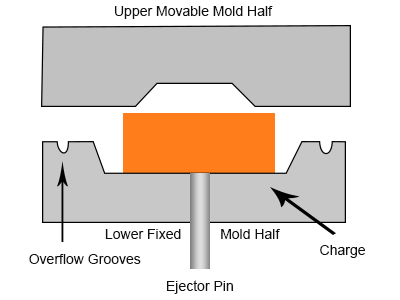Compression Molding
Get Online Quotes in 12 Hours
Compression Molding
- The world’s only 12-hours injection molding quote
- Samples shipped in as little as 15 days

THE BEST BRANDS PUT THEIR TRUST IN JINTAI MOLD






Compression Molding
Compression molding is a manufacturing process that uses pressure to mold parts. A heated rubber material is placed in one side of a mold. The other side of the mold is then clamped down, and the rubber material is compressed into the desired shape. The mold must be heated, as the combined compression and heat is what causes the rubber to take its new shape. The mold also has to be designed to meet certain criteria for compression manufacturing. Compression molds need to have overflow grooves to allow excess material to exit the mold. It is difficult to accurately predict the amount of rubber material needed without any overflow. Using a little extra material will ensure the mold is filled completely and the product comes out as intended. The excess material is referred to as flash and must be trimmed after the compression molding has been completed.
Cost is one of the driving factors behind the popularity of compression molding. Compression mold tooling is much cheaper than tooling for a comparable process like injection molding. Compression molds are far less complicated, requiring fewer machine hours to complete. Compression molds do not require the gates and runners needed for injection molding.
What are the Advantages of Compression Molding?
What are the Disadvantages of Compression Molding?
Cycle time is the main drawback when considering compression molding. One cycle can last several minutes. A technician has to manually place the material into the mold, heat it up, apply pressure, and then wait for the mold to cool off enough to remove the part before starting the process again. Multi-cavitation is a way around this issue.
Parts will require some post processing after they are molded. Flash is the excess material that is squeezed out of the mold during compression. The flash will still be attached to the main product in some areas and will need to be manually removed.
Compression molding is an ideal choice for simple products but may leave under-filled sections if the design is too complex.
Process for Compression Molding
Jintai Mold’s online quoting system enables us to simplify and shorten both the quoting and tool manufacturing process for compression molding.
- Upload the 3D CAD file to get a mold and part quote instantly.
- Upon order confirmation, Jintai Mold starts the mold and part order process.
- Tooling design review by Jintai Mold engineers.
- Upon design approval, Jintai Mold begins building your injection mold.
- Customer examines samples for approval.
- Part production begins.
Compression Molding Services

